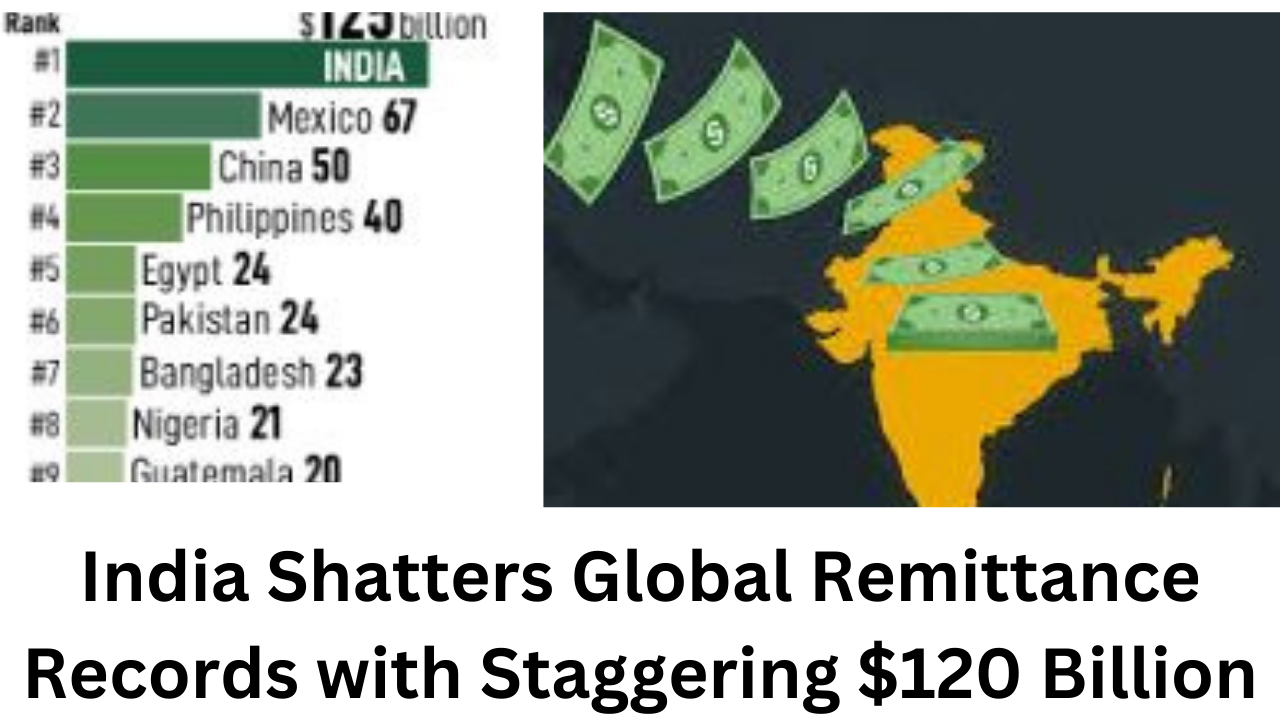India’s Remittance Hits All-Time High of $120 Billion in 2023
According to multiple reports, India received a record $120 billion in remittances in 2023, the highest amount for any country in the world. Key highlights: Highest Remittances Globally
- India received $120 billion in remittances in 2023, almost twice the $66 billion received by Mexico, the second highest recipient.
Driving Factors
- Strong labor markets and low inflation in the U.S., the largest destination for skilled Indian migrants
- Positive demand for skilled and unskilled workers in the Gulf Cooperation Council (GCC) countries, the second largest destination for Indian migrants
- India-UAE agreement in February 2023 to promote local currency usage and interlink payment systems, helping channel more remittances through formal channels
Forecast Growth
- Remittances to India are forecast to grow further, reaching $124 billion in 2024 and $129 billion in 2025.
- The diversification of India’s migrant workforce between highly skilled OECD workers and less-skilled GCC workers is expected to provide stability to remittance flows.
Importance of Remittances
- The World Bank emphasizes the importance of migration and remittances as drivers of economic and human development.
- It aims to reduce remittance costs and facilitate formal flows to promote investment and financial inclusion in recipient countries like India.
This record-breaking $120 billion in remittances underscores India’s status as a global leader in receiving overseas worker transfers, which play a vital role in supporting its economy and development.
Impact of NRI Remittances on India’s Foreign Exchange Reserves and GDP
NRI remittances have a significant impact on India’s foreign exchange reserves and GDP. Here are some key points:
NRI remittances have a significant impact on India’s foreign exchange reserves and GDP. Here are some key points:
Boosting Foreign Exchange Reserves
NRI remittances are a major source of foreign currency inflow, adding directly to India’s foreign exchange reserves.
In times of economic uncertainty and global financial volatility, these reserves play a crucial role in ensuring macroeconomic stability.
NRI remittances are a major source of foreign currency inflow, adding directly to India’s foreign exchange reserves.
In times of economic uncertainty and global financial volatility, these reserves play a crucial role in ensuring macroeconomic stability.
Contribution to GDP
NRI remittances contribute substantially to India’s Gross Domestic Product (GDP), especially during economic slowdowns.
The influx of funds boosts the purchasing power of the populace, stimulating consumption and driving both demand and supply in the economy.
NRI remittances contribute substantially to India’s Gross Domestic Product (GDP), especially during economic slowdowns.
The influx of funds boosts the purchasing power of the populace, stimulating consumption and driving both demand and supply in the economy.
Fueling Investment and Growth
Remittances encourage consumer spending and investment across various sectors like real estate, retail, education, and healthcare.
This catalyzes a ripple effect that energizes multiple industries, aids in job creation, and promotes overall economic growth.
Remittances encourage consumer spending and investment across various sectors like real estate, retail, education, and healthcare.
This catalyzes a ripple effect that energizes multiple industries, aids in job creation, and promotes overall economic growth.
Cushioning Against External Shocks
During economic crises or global downturns, the consistent flow of remittances serves as a financial cushion for India.
It provides a stable source of foreign currency, helping to offset the impacts of external shocks on the Indian economy.
During economic crises or global downturns, the consistent flow of remittances serves as a financial cushion for India.
It provides a stable source of foreign currency, helping to offset the impacts of external shocks on the Indian economy.
Scale and Importance
As of 2017, India was the world’s leading receiver of remittances, accounting for more than 12% of global remittances.
This staggering figure underscores the immense contribution of the Indian diaspora to the nation’s economic stability.
While managing remittance flows poses certain challenges in terms of efficiency and security, the overall impact of NRI remittances on India’s foreign exchange reserves and GDP is undeniably significant. As India continues to grow, the consistent support from its non-resident citizens will remain a vital part of its economic success story.
As of 2017, India was the world’s leading receiver of remittances, accounting for more than 12% of global remittances.
This staggering figure underscores the immense contribution of the Indian diaspora to the nation’s economic stability.
While managing remittance flows poses certain challenges in terms of efficiency and security, the overall impact of NRI remittances on India’s foreign exchange reserves and GDP is undeniably significant. As India continues to grow, the consistent support from its non-resident citizens will remain a vital part of its economic success story.
Impact of Remittances on the Balance of Payments
Improving the Current Account Balance:
Remittances are recorded as credits in the current account, specifically in the income account.
This helps offset deficits in the trade balance, as the inflow of foreign currency from remittances can compensate for a country importing more goods and services than it exports.
Remittances are recorded as credits in the current account, specifically in the income account.
This helps offset deficits in the trade balance, as the inflow of foreign currency from remittances can compensate for a country importing more goods and services than it exports.
Providing a Stable Source of Foreign Exchange:
Unlike other capital flows like foreign direct investment or portfolio investment, remittances tend to be more stable and less volatile.
This is because migrant workers often continue sending money home to support their families, even during economic downturns.
The consistent inflow of foreign currency from remittances helps stabilize a country’s foreign exchange reserves.
Stimulating Economic Growth:
Remittances can boost domestic consumption and investment, as the additional income is often used for essential spending and entrepreneurial activities.
This can lead to increased demand for goods and services, which can in turn stimulate economic growth, provided the domestic supply can meet the increased demand.
Unlike other capital flows like foreign direct investment or portfolio investment, remittances tend to be more stable and less volatile.
This is because migrant workers often continue sending money home to support their families, even during economic downturns.
The consistent inflow of foreign currency from remittances helps stabilize a country’s foreign exchange reserves.
Stimulating Economic Growth:
Remittances can boost domestic consumption and investment, as the additional income is often used for essential spending and entrepreneurial activities.
This can lead to increased demand for goods and services, which can in turn stimulate economic growth, provided the domestic supply can meet the increased demand.
Attracting Foreign Investment:
If the recipients of remittances save the money in the domestic banking system, it can increase the banks’ deposits and lending capacity.
This can make the country more attractive for foreign investors, leading to an inflow of capital in the financial account of the balance of payments.
If the recipients of remittances save the money in the domestic banking system, it can increase the banks’ deposits and lending capacity.
This can make the country more attractive for foreign investors, leading to an inflow of capital in the financial account of the balance of payments.
Offsetting Balance of Payments Deficits:
Remittances can help developing countries offset chronic balance of payments deficits, as they provide a stable source of foreign currency that is not tied to specific investment projects or loan repayments.
remittances have a positive impact on a country’s balance of payments, helping to improve the current account, stabilize foreign exchange reserves, and stimulate economic growth and investment. The consistent and often countercyclical nature of remittance flows makes them a valuable component of a country’s international accounts.
Remittances can help developing countries offset chronic balance of payments deficits, as they provide a stable source of foreign currency that is not tied to specific investment projects or loan repayments.
remittances have a positive impact on a country’s balance of payments, helping to improve the current account, stabilize foreign exchange reserves, and stimulate economic growth and investment. The consistent and often countercyclical nature of remittance flows makes them a valuable component of a country’s international accounts.









